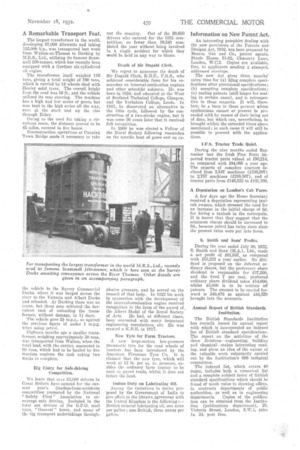A Remarkable Transport Feat.
Page 47

If you've noticed an error in this article please click here to report it so we can fix it.
The largest transformer in the world, developing 97,000 kilowatts and taking 125,000 h.p., was transported last week from Walton-on-Thames to Barking by M.R.S. Ltd., utilizing its famous Scaminell 1450-tonner, which has recently been equipped with a Gardner six-cylinde red oil engine.
The transformer itself weighed 116 tons, giving a total weight of 160 tons, which is carried by 14 wheels shod with Henley solid tyres. The overall height from the road was 16 ft., and the vehicle utilized its rear steering. The machine has a high and low series of gears, but was kept in the high series all the way, even at the start and up the rise through Esher.
Owing to the need for taking a circuitous route, the distance proved to be 45 miles, covered in five hours.
Reconstruction operations at Canning Town Bridge made it necessary to take
the vehicle to the Surrey Commercial Docks, where it was barged across the river to the Victoria and Albert Docks and reloaded. At Barking there was no crane, but three men achieved the herculean task of unloading the transformer, without damage, in 1i• days.
The vehicle gave 2 m.p.g., as against the previous figure of under 1 m.p.g. when using petrol.
Eighteen mouths ago a smaller transformer, weighing approximately 50 tons, was transported from Walton, when the total load, with the carrier, amounted to 90 tons, which had to be hauled by five traction engines, the task taking two weeks to complete.
Big Entry for Safe-driving Competition.
We learn that over 53,000 drivers in Great Britain have entered for the current year's freedom-from-accidents competition promoted by the National " Safety First" Association to encourage safe driving. Included in the total are drivers of the G.P.O. mail vans, " General " buses, and many of the big transport undertakings through out the country. Out of the 50,650 drivers who entered for the 1931 competition, no fewer than 38,541 completed the year without being involved in a single accident for which they gould be held in any -way to blame.
Death of Sir Dugald Clerk.
We regret to announce the death of Sir Dugald Clerk, K.B.E., F.R.S., who achieved considerable fame for his researches on internal-combustion engines and other scientific subjects. He was born in 1854, and educated at the West of Scotland Technical College, Glasgow, and the Yorkshire College, Leeds. In 3881, he discovered an alternative to the Otto cycle, followed by the Construction of a two-stroke engine, but it was some 30 years later that it received. full recognition.
In 1908 he was elected a Fellow of the Royal Society following researches on the specific heat of gases and on ex
plosive pressure, and he served on the council of that body. In 1922 his work in connection with the development of the internal-combustion engine received recognition in the form of the award of, the Albert Medal of the %Val Society of Arts. He had, at different times, been connected with many important engineering associations, etc. Be was Created a K.B.E. in 1917.
New Tyre for Farm Tractors.
A new large-section low-pressure pneumatic tyre for the road wheels of tractors has been introduced by the American Firestone Tyre Co. It is claimed that the new tyre, which will work at 12 lb. per sq. in. pressure, enables the ordinary farm tractor to be used on paved roads, whilst it does not injure the land.
Indian Duty on Lubricating Oil.
Among the variations in duties proposed by the Government of India to give effect to the Ottawa agreement with the United Kingdom is the following:— British mineral lubricating oil, one anna per gallon ; non-British, three annas per gallon.




















































































































